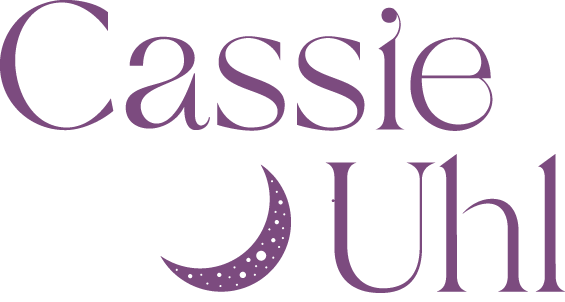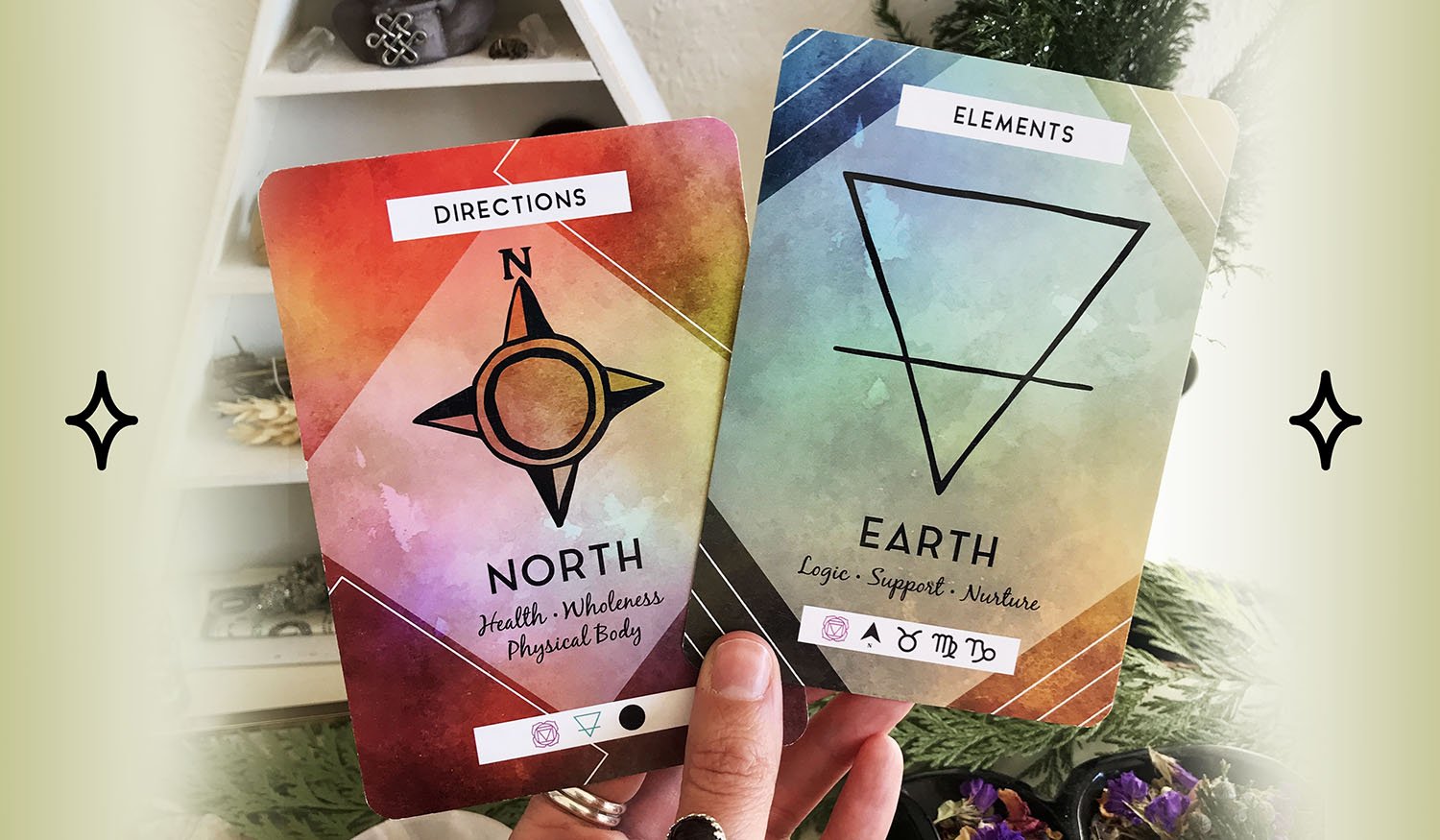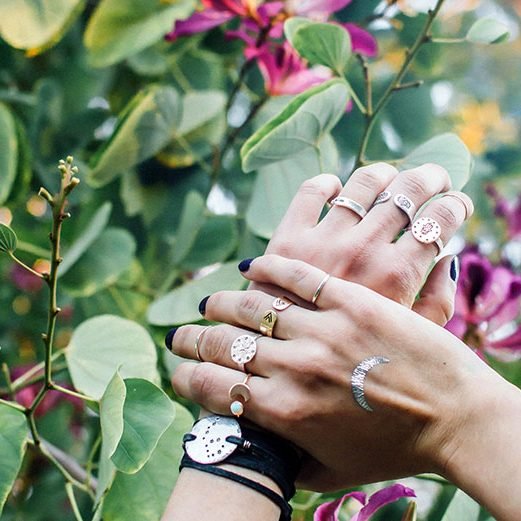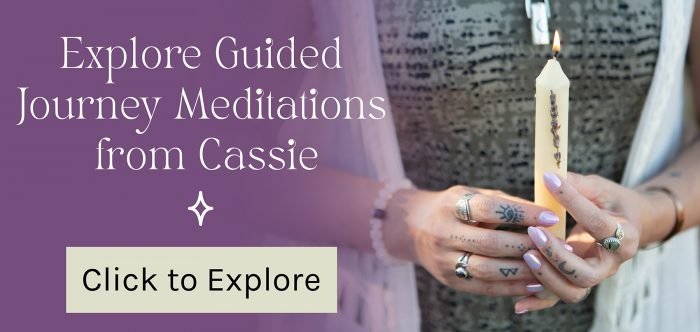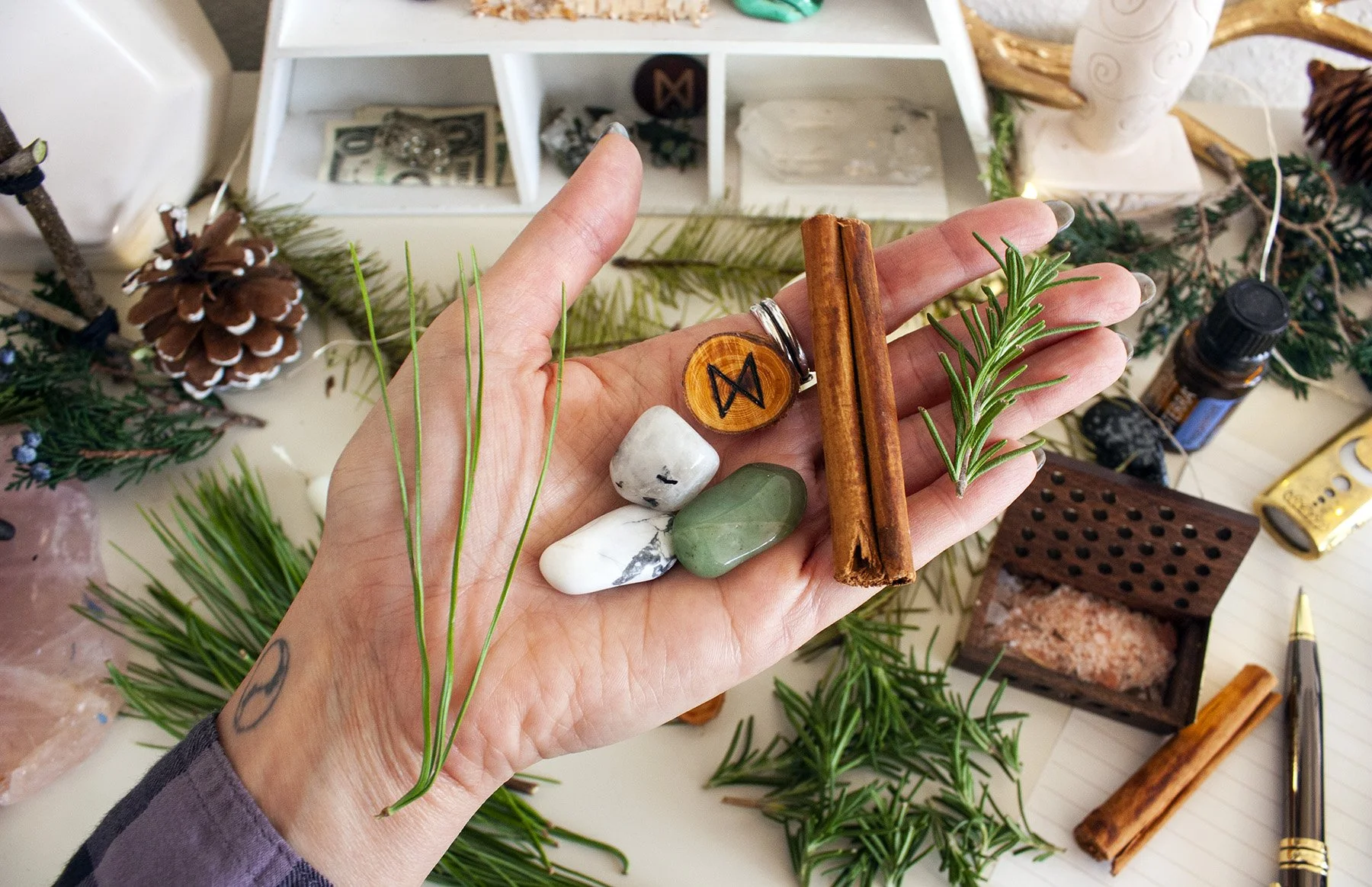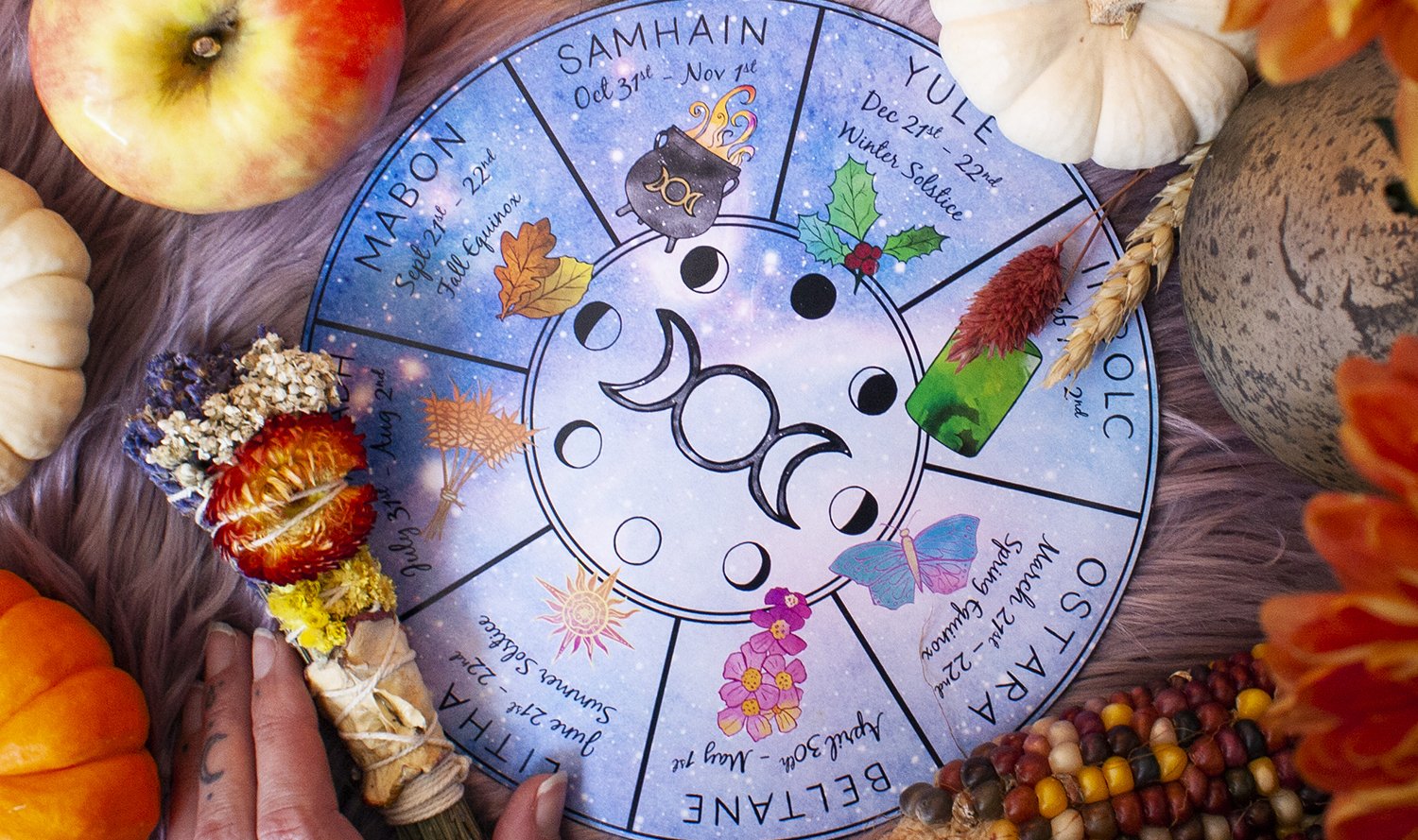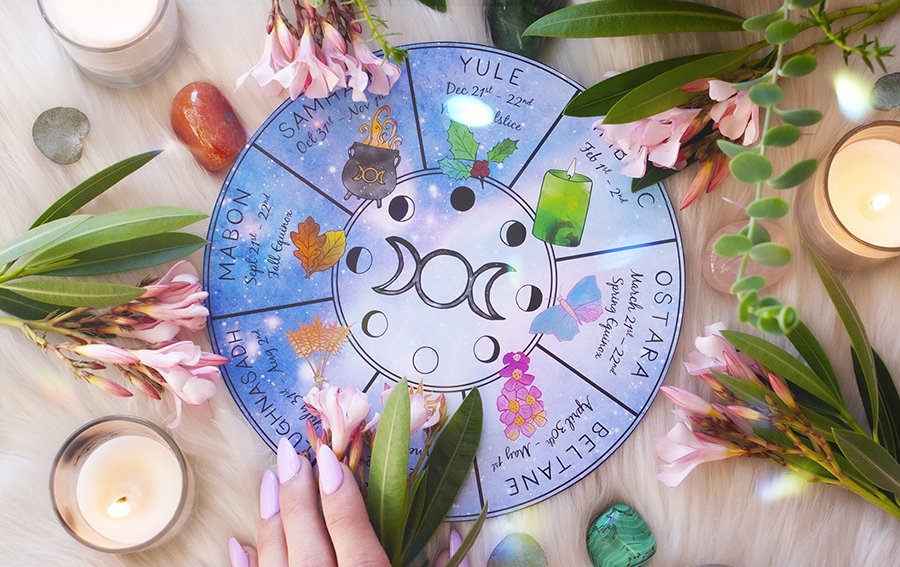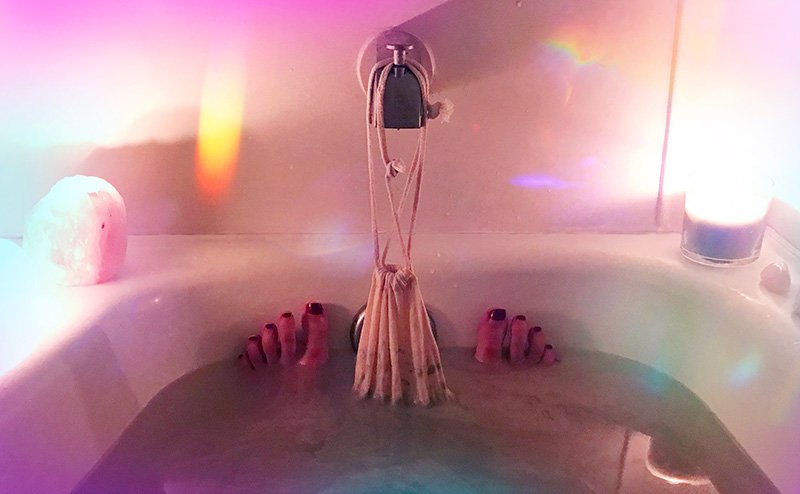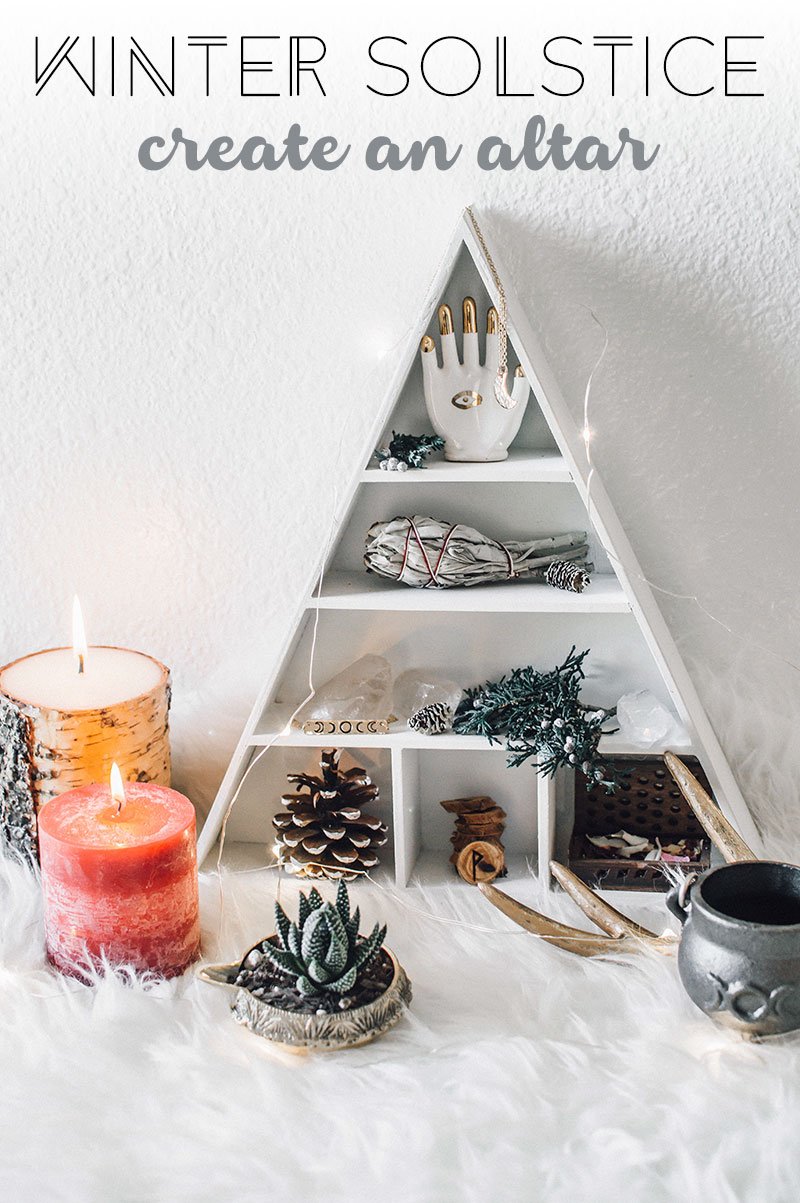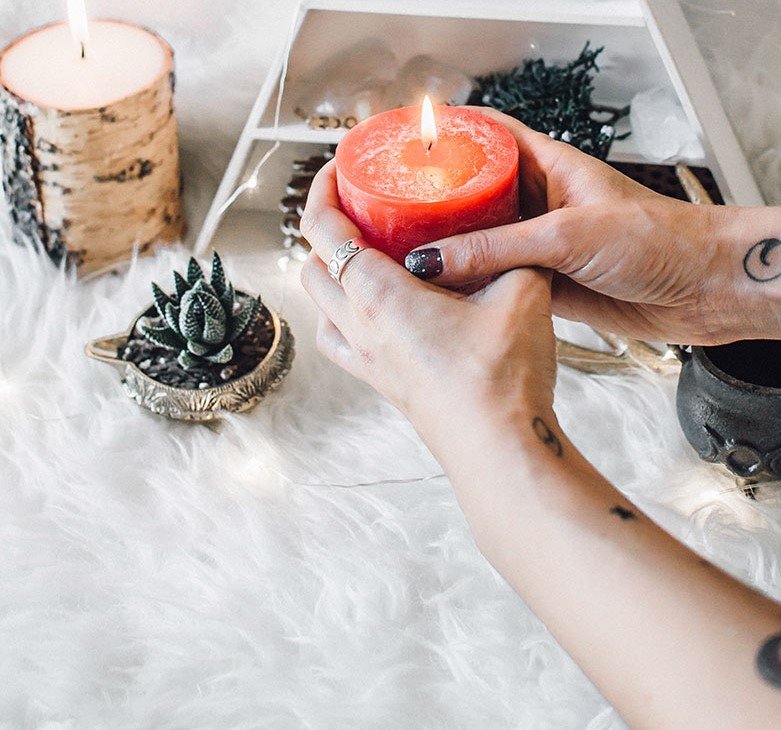A Card Spread for the Winter Solstice
The winter solstice, or Yule, is the year's shortest day and longest night. Yule is a sabbat on the Wheel of the Year that marks midwinter, and even though it’s the darkest time of the whole year, it represents a time of death and rebirth. Here is a card spread to help identify, grieve, and release what’s ready to be shed and reborn within yourself this season.
The winter solstice, or Yule, is the shortest day and longest night of the year. Yule is a sabbat on the Wheel of the Year that marks midwinter, and even though it’s the darkest time of the whole year, it represents a sacred portal of death and rebirth. If you're new to The Wheel of the Year, you can find more about it here.
After Yule, each day begins to get a little more light and a little less dark. It’s a time to celebrate the return of the light.
Yule is associated with evergreen, holly, ivy, mistletoe, red, white, green, gold, and fire. Sounds a little bit like Christmas, right? The pagan holiday of Yule predates Christmas, and when Christianity swept through Europe, Yule's traditions were woven into the Christian holiday of Christmas.
Like many of us witches, pagans, and/or spiritual folks, you may honor both Yule and Christmas.
Keep scrolling to find a tarot or oracle card spread for this Winter Solstice and Yule and other ways you might like to honor this sabbat.
A CARD SPREAD FOR YULE
Take some time to create a ritual space before you pull your cards. Gather a few candles, light some incense or other herbs, and ground yourself before dropping in with your cards. Set an intention for your intuition, your highest self, and/or your spirit guides to communicate with you through the cards.
When you feel ready, shuffle your cards and pull one card for each of the following questions:
What themes are surfacing most prevalently, within and outside of me?
How can I tend to and grieve what wants to surface?
What's ready to pour into the cauldron of the earth this Solstice?
How can I care for myself during this tender time of shedding?
What wants to be reborn, within and outside of me?
Image copyright Cassie Uhl 2023.
Consider sitting with your cards, journaling, and meditating for a while to help you process their medicine and really move the messages through your body.
Some other sweet ways to honor the Winter Solstice and Yule:
Light candles
Gather around a fire with loved ones
Connect with local evergreen trees
Burn pine incense
Meditate on a candle flame or fire
Honor the wisdom of darkness by spending time inside or outside with the darkness of the season.
Create a Yule altar with holly sprigs, pinecones, evergreen branches, and red, green, or white candles and crystals
Find more ideas here
How will you be honoring Yule this year? Let me know on Instagram.
Understanding the Element of Earth
On the sacred wheel, the North encompasses the realm of earth, winter, death, rebirth, and your ancestors. The North is the still and sacred portal where we're allowed to break down and shed to rebuild for a new cycle. It is the seat of deep wisdom where the ancestral knowledge from all of those who've come before you resides. The North encompasses endings, new beginnings, and the space in between.
On the sacred wheel, the North encompasses the element of earth, winter, death, rebirth, and your ancestors. The North is the still and sacred portal where we can break down and shed to rebuild for a new cycle. It is the seat of deep wisdom where the ancestral knowledge from all those who've come before you resides. The North encompasses endings, new beginnings, and the space in between.
In this post, you’ll be able to explore the wisdom of the earth element and the North. You'll also learn common correspondences and ways to build relationship with the North. Because this is the first in a series of posts, I'll also spend some time discussing sacred circles and wheels in various cultures and how they're used with the directions and elements.
Listen to this on my podcast here.
I started working with the cardinal directions in my practice years ago, initially to cast a circle and create sacred space. My work with the wheel has evolved, and working with the directions and wheel has become an intrinsic part of my practice. I use the wheel as a tool to connect with the seasons, the cardinal directions, the elements, and all of the wisdom each section encompasses. Circles similar to the seasonal wheel used by many Celtic, Druidic, and Wiccan spiritual practices are sacred across many cultures and have a lot of overlap in meaning.
If you'd like a frame of reference for the sort of wheel I'll be referring to throughout this share and series, you can find one in my book "Understanding the Wheel of the Year." The wheel I created for the book shows each season's color, direction, elemental, lunar, and zodiac alignments. If you don't have the book, I've shared an image below, and if you're listening, feel free to pause and look up this share on my blog.
It's a common framework used by cultures worldwide, though you will find subtle differences from practice to practice. Let's start there and look at how other cultures work with sacred wheels.
Sacred Wheels Across Cultures
The medicine wheel or sacred hoop is a tool and symbol used by many First Nations and Indigenous cultures from the land referred to as Canada and North America. Stone structures that have been used for ceremonial purposes dating back as early as 3200 BCE have been found in Canada. Though stone structure dates back far into the past, medicine wheels and sacred hoops are still alive today with many Indigenous people and communities. They can be used for ceremony, ritual, and to connect with the four directions, elements, animals, and more.
In Mongolian Cosmology, the ger often referred to as a yurt here in the West represents a sacred wheel. The ger is viewed as a microcosm, or a map, of the universe. Each direction has a unique significance related to who and what resides in that location and what takes place. For example, the entrance of the ger always faces North, the fire is always at the center, women sit on Eastside, and men on the West.
In yogic practices, the directions hold significance as well. It is not uncommon to face specific directions for specific asanas and meditations. There are myths, Gods, and Goddesses associated with each direction which each share insights about the significance of each direction in yogic philosophy. I'm always intrigued by the overlap in different cultures around common spiritual tools and symbols. Here, in an article from Pandit Rajmani Tigunait of Yoga International, he shares a bit about the direction of the North in Yogic tradition, "The North is determined by the polar star, the symbol of stability; it is the fixed goal that never wavers. It represents unshakable conviction." I love this because it's similar to my understanding and relationship with the North.
Of course, these are just little snippets of each of these sacred practices.
There are symbols and practices throughout Europe that use sacred wheels, although, as usual, with little historical reference. The sun cross or solar wheel, a circle with a cross in the middle, is a common symbol found throughout prehistoric Europe. However, even the name that was given to this symbol, the "sun cross," is relatively new, which shows how little we truly know about its true significance. Between the sun cross and circular structures like Stonehenge and Woodhenge, it's not difficult to see that wheels were sacred to many throughout Europe.
Today many practices like Wicca and Druidry use the wheel in different ways like connecting with the seasons, elements, cardinal directions, creating sacred space, and more. This is how I connect with the wheel in my practice and the lens through which I'll be sharing from here.
Before we dive into the bulk of this share, I want to give you a little bit of a reference of my process for this share and how I intend to craft future shares in this series. The North is an important topic because it encompasses many other significant issues like the element of earth, Wintertime, our ancestors, and more. My goal with this share and the future directions is to give you a framework to begin building a relationship with the North and its many facets. Much of what I share will be from my personal experiences building a relationship with the North. As always, remember that your experiences may differ based on your cultural background and personal gnosis.
I've been spending a lot of time connecting with my local nature spirits and journeying about the topic for this post. This share has not come easily to me. I have a deep reverence for the North and a feeling of not wanting to get it wrong. The North and the earth element are our sacred foundation and the home of our ancestors, and it feels relevant that I stress the importance and sacredness of the North.
Let's begin exploring the wisdom of the element of earth and the cardinal direction, North.
The Wisdom of Earth & North
Earth and North are the cauldron of creation encompassing death, birth, and the space between these realms. It is the simultaneous end and beginning of the dark moon phase. I think our linear human minds sometimes struggle with this. We're so used to endings and beginnings that a pause between the two, or the idea that endings and beginnings live in the same space, seems somewhat foreign. But, of course, we can always find glimpses of this in nature.
Even here in the desert, I find subtle reminders of the wisdom of the North and those in-between spaces. There's an oleander plant I often notice on my walks. It seems to be always blooming. However, since around the time of the Winter Solstice, it's dropped its flower and, as of recently, has formed tiny buds. I've enjoyed noticing how long the buds have been there, waiting, as the plant rebuilds and absorbs more nutrients to bloom again. I've used it as a bit of a marker for myself as I find myself in a similar space of rebuilding. It's been a comforting reminder to pay more attention to plants in their death and "in-between" phases this winter season. People often ask how I connect with the seasons being in the desert, and I'm here to tell you that the seasons are very much alive, even in the desert, albeit on a smaller scale.
Wintertime, the season of the North, also coincides with our shift into Capricorn season. It makes my heart sing when these seasons overlap so perfectly. Capricorn is a cardinal earth sign and corresponds with the planet of Saturn. The cardinal earthy energy signals a time to build a solid foundation upon which we can build. The Saturn correspondence invites in structure. These themes fit perfectly into the realm of the North and the element of earth.
Understanding what tools you need to build a strong foundation requires time and introspection. I'd say there's even a thread of shadow work that weaves through this space. To create a solid foundation, you'll need to take stock of what's working and what's not working in your life, assess where you need to set different boundaries and notice where you may need to ask for help or call in reinforcements. Deep processing, shedding, and collecting happen in the North.
Your body and physical wellbeing correspond with the North and this season as well. You are the earth of the North. We often forget that our bodies are nature itself. This space is an invitation to notice how you're tending to your body or your physical foundation. The North is where we address the physical body's needs, so you feel safe and supported during this incarnation. The earth and all its inhabitants live within the realm of the North. Everything comes from the earth and will decompose back into the earth. The earth is the foundation for all life.
This is where your ancestors come in. You have centuries of ancestral knowledge living within your blood, bones, and DNA. Outside of your physical body, there's ancestral knowledge within the soil, stones, and water as well. Of course, not all of our ancestors have left positive influences that will be for you to parse out, work with, and hea. But there's wisdom and learning nonetheless. On a very physical level, the earth below your feet holds the wisdom of every ancestor who's come before you. When you connect with the power of the North, you connect with this wisdom and knowledge.
We often think of connecting with those on the other side as somewhere outside of us or up in a heaven of sorts. While it may be that the spirits of our ancestors are in a different realm, their blood, bones, and all of the wisdom therein have been absorbed back into the earth. This is why we connect with the ancestors in the earth and the wisdom of the North on a very physical level. That is where their wisdom lives.
Are you're starting to see and feel the layers of this sacred space emerge?
Correspondences for Earth & North
You could probably pick up on several correspondences from what I shared above. Here are a few more common energetic connections for the North. A quick note before I dive in: as I shared earlier, the cardinal directions and the elements are spiritual practices that show up across cultures. It's also important to remember that you may have unique connections to the directions and their correspondences. Suppose the way you connect with each direction varies from what I share here. That is normal and certainly not a reason to discount your connections or mine, whether it be from another culture or a personal connection.
Correspondences for the North
Element: Earth
Season: Winter
Time of day: Midnight
Moon Phase: Dark moon
Tarot: Pentacles
Colors: black, brown, green, white
Animal: bear or any other earthy animal you connect to the North
Other: dirt, stones, plants, bones, clay
Working with corresponding tools is one way to help honor and connect with the energy associated with the North. Tools and symbols can draw our awareness to where we are trying to focus. I will also share ways to use these correspondences in the following section.
Three Ways to Connect with the Earth Element
Now my favorite section! You hear me say this often because it's been so true for my practice. For there to be a connection or learning to happen, there must be relationship. So before any deep work can be done within the North and its many corresponding energies, I encourage you to build a relationship with the North.
Understanding each direction on the wheel has far less to do with what I share here and much more to do with how you experience them.
There are so many ways to begin building a relationship with the North and the earth, and I find it is a beautiful starting point because it is a place of foundations. The North is the infrastructure for the rest of the wheel and your spiritual practice and an ever-present touchpoint you can come back to at any time to feel supported and to tap into a deep well of wisdom. That said, there are many who also like to start in the East as it is a place of new beginnings. For example, when I cast a circle, I begin with the East and end with the North. I'll leave it up to you, but in my opinion, there are no strict rules about this, especially when deciding where to begin forming a deeper relationship.
If you are looking for more personal guidance, as I mentioned earlier in this share, I am offering my "Journey to the Ancestors," which will provide a more robust look at connecting with the North with even more tools, including journal prompts a card spread, and guided journey meditation.
Here we'll focus on connecting with the earth and your local natural environment, tuning into your physical body, and journeying or meditating on the North.
1. Connecting with the earth
Because the North encompasses the element of earth, connecting with the earth is a powerful portal to experience the North and its wisdom. There are so many ways to connect with the earth, and you likely already have some beautiful practices to help you do this. For me, the most powerful way I've found to connect with the earth is through regular connection with my natural environment. I do this by going on regular walking meditations, usually 15-30 minutes 4-5 times a week. As always, I encourage you to try whatever feels like a doable and sustainable amount of time for you and your unique schedule.
When I walk, I try to focus my full attention on the environment around me. I say try because, just like sitting meditation, my mind tries to remind me of all of my to-do's and interject with other random thoughts. To help me stay present and aware, I have a process to become more engrossed in my surroundings. I do this by noticing the temperature, the speed of the wind, the warmth and location of the sun, how the ground feels beneath my feet, how the air feels in my mouth and lungs, varying sounds of the animals, and any changes in different trees and plants.
I've found that connecting with nature regularly and intentionally creates a very natural pathway to forming a deep relationship with the earth and your environment. You'll soon see patterns and cycles of death and rebirth all around you, perhaps in ways that you hadn't previously noticed. You'll begin to feel more connected to the plants, animals, and soil. These relationships can then initiate a more profound unfolding and help you to form a deeper relationship with the element of earth, your ancestors, and the realm of the North.
2. Connecting with the physical body
Another way I enjoy connecting with the realm of the North and the element of earth is by focusing on my physical body. Your body is a deep well of wisdom. Sometimes we discount this wisdom, especially when our physical bodies do not feel or perform the way we want them to or think they should.
The North reminds us that the body is a living vessel of cyclical wisdom, just like nature. Just like the oleander plant I mentioned earlier, you are not intended to bloom at all times either, nor are you intended to be a picture of perfect health at all times. Like nature, our bodies encounter seasons of sickness, decay, and growth. There is not one stage that is more spiritual than another, and you are not less spiritual if your body or mind experiences temporary or long-term illness. Have you ever looked at a tree losing its leaves and thought, "what a stupid tree? It must not have absorbed enough of the right kind of nutrients. Otherwise, it wouldn't be losing its leaves." I gather you probably haven't, but how often have you had thoughts like this about yourself or another person?
It might seem like an unusual concept to build a relationship with your body, the very vessel you reside in, but I think, much like the earth, it's something we often take for granted. Our bodies always give us signs and nudges about what we need and don't need, but we don't always listen. When you permit yourself to connect with the body more regularly, you create a pathway to build a relationship with it and learn from its wisdom.
Connecting with my body in a very intentional way is something I usually do before any meditation. You can add another layer of energy to this practice by facing North for a body meditation, either lying down with your head pointing towards the North or by sitting up and facing the North. I like to start at my feet and work my way up through the body. I try to notice each area, how it feels, and what the energy of each space is bringing up.
I think a lot of us become accustomed to certain sensations so much so that we don't even notice when our body is trying to tell us it's time to pause or try something different. I'd also like to point out that I'm 100% not implying here that meditation can be a cure-all for all physical ailments. Nope, sometimes the sensations you tune into may indicate that it's time to see a doctor. But, in this instance, it helped me draw my attention back to my body to start using some tools to tend to my nervous system and body in ways that I previously hadn't been doing.
The wisdom from the North here is that when we tune into the body, it will often tell us what it needs to feel better supported. Sometimes this looks like allowing more time for rest, eating nourishing foods, moving the body more, or reaching out for support from a doctor. Our bodies are wise beyond what our human brains can even fathom.
If you'd like to explore a body-focused meditation, my "Meditate with the Moon" guided meditation package offers a body scan meditation for the dark moon phase that is a great way to tune into your body and connect with the North.
3. Journeying and meditation
Another way to deepen your relationship is to journey to the North or meditate on the North. This can be a really powerful way to deepen your relationship with the North. The previous invitations can also help pave the way to connecting through meditation and journeying. This technique can be especially helpful when you want to connect with your ancestors.
First, a bit about meditation vs. journeying, because they are different and often interchangeably, even by myself. I've mentioned journeying here in this space, but I haven't spent much time going into detail about what it is.
There are likely others who will have a different opinion than I do, but these are my thoughts. I think of meditation as an umbrella term for training the mind to be more present and aware. However, there are many different kinds of meditation. I think of journeying as one kind of meditation. Journeying is akin to astral travel in that you focus your awareness on journeying to somewhere in the astral plane. Though it can be like an out-of-body experience, it often occurs within the mind's eye.
This is a brief introduction to journeying, I could spend an entire post on what journeying is and different techniques, and I probably will someday. I think the best place to get started when wanting to learn how to journey is to meditate regularly and begin building your anchor point or the location within the astral realm that's your home. The better you visualize and hold the visualization, the more natural journeying will come to you over time. You can also get a taste for journeying in my free guided mediation to meet your spirit guides. That's a free offering for joining my email list, which you can find here. Or join me in my monthly journey, which this month is to your Ancestors in the North.
If journeying is a part of your practice, I encourage you to try this method for connecting with the North. If journeying is new to you, I encourage you to try a meditation on the North. There's still deep wisdom there as well. To do a meditation to the North, I'd invite you to bring in some physical elements representing the North, like a black/brown candle or a stone, and to face the North. I'd also suggest stating aloud or in your mind that you desire to connect with the North. Then, close your eyes, connect with your breath and body and see where your mind takes you. How do you feel, what do you see in your mind's eye, and do any messages come through? This may take more than one go, and that's okay. Remember, building a relationship takes time.
Meditating or journeying to the North can be a powerful tool when you need wisdom around matters of the North, like death, birth, the physical body, and ancestral healing.
I hope in reading this you already feel more connected with the North and all its wisdom and that it's encouraged you to start building a deeper relationship with this "space." Getting this share out feels like a birth for me. It took me a long time to gather my thoughts around this big topic, so I hope you enjoyed it! I plan to explore the East around the equinox when our wheel shifts to the Spring.
Sources
The Ger and the Sacred Circle: http://buryatmongol.org/a-course-in-mongolian-shamanism/mongolian-cosmology/the-ger-and-the-sacred-circle/
Four Elements, Four Directions: Is that Celtic or Druidic:
https://www.oocities.org/rainforest/canopy/2178/celtic2.html
The Significance of the four directions in practice:
https://yogainternational.com/article/view/the-significance-of-the-four-directions-in-practice
Lakota Medicine Wheel:
http://aktalakota.stjo.org/site/News2?page=NewsArticle&id=8592
Winter Solstice & Yule Spell Jar for Rebirth
The winter solstice, also called Yule in Germanic traditions, is the longest night and shortest day of the year. It is the time we have the most darkness, and after the winter solstice, the sun returns — growing each day.Because of this darkness and the return of the light, the solstice is deeply associated with rebirth. A kind of new year for witches, if you will. In this blog post, I’ll share how to make a DIY spell jar for rebirth in honor of the winter solstice. This would be a great practice to do on the winter solstice or in the days after it! So what are spell bottles or jars? Spell jars are a form of folk magic that can be used for many different purposes. I share more about spellwork below - keep scrolling to read it!
The winter solstice, also called Yule in Germanic traditions, is the longest night and shortest day of the year. It is the time we have the most darkness, and after the winter solstice, the sun returns — growing each day.
Because of this darkness and the return of the light, the solstice is deeply associated with rebirth. A kind of new year for witches, if you will. In this blog post, I’ll share how to make a DIY spell jar for rebirth in honor of the winter solstice. This would be a great practice to do on the winter solstice or in the days after it!
So what are spell bottles or jars? Spell jars are a form of folk magic that can be used for many different purposes. I share more about spellwork below - keep scrolling to read it!
A LITTLE ABOUT SPELLWORK
To me, spells are about directing energy in a specific direction. They’re about using magick, which Dion Fortune defines as “the art of changing consciousness at will,” for healing, manifestation, and connection.
I believe that they can be simple, and all you really need is yourself and your energy. Other items, like the ones we’ll use in this spell, are supportive in infusing some extra magick and energy into the work — but you don’t need them to do spells.
WHAT YOU’LL NEED
For this spell, you’ll need:
As with all spells, use what you have. Feel free to substitute items, and don't worry if you're missing something from this list. Your intention is the most important part of any spell!
A glass bottle/jar of any size
Salt of any kind for protection
A piece of paper and pen to write your intention
3-5 drops of oil that supports rebirth like eucalyptus or peppermint
Stones that represent rebirth to you like moonstone, green aventurine, and howlite for peace as you transform. Other stone options could include malachite, citrine, moss agate, or quartz.
Dried or fresh herbs that support rebirth like spruce, pine, or nettle.
Dried or fresh rosemary for clarity and protection.
Cinnamon stick for luck
Dagaz rune, which represents dawn. This can be placed inside your jar or drawn/painted on the outside of your jar.
White candle
Any other representations of rebirth for you
Let yourself be intuitive with your spell ingredients, and feel free to use what you have around you!
SPELL STEPS
Like any spell, you’ll want to center and ground yourself before working the spell. You might spend a few minutes meditating, letting your eyes drift around your space, or doing breathwork or anything else that feels grounding to you. Find ideas for grounding here.
When you feel ready, cleanse each of your items. You can use smoke, sound, salt, or another cleansing technique you align with.
Write your intention for the spell on the paper to add into your bottle.
If you’d like, you can paint your bottle with symbols that represent rebirth to you.
After your bottle is ready, take your time to place each item inside your bottle intentionally. Raise energy as you do this, either with deep breaths or chanting. I recommend coming up with your own chant that focuses energy on connecting to your intuition and developing your intuitive abilities.
When you’re done filling your bottle, seal it, hold the vessel in your hands, and keep chanting or breathing as long as you’d like.
Light your white candle and place it on top of or next to your spell bottle. Be mindful of your candle surroundings and never leave your candle burning unattended. Tip: Melt the bottom of your candle with a flame to make it stick to the top of your jar.
Spend time meditating on your intention as your candle burns. Connect with the feeling of rebirth. Visualize rebirth moving through your cells, making you whole. What would it feel like, look like, even sound like, to be reborn?
Ground the energy after your meditation by placing your palms on the ground and returning any excess energy to the Earth.
I recommend placing the bottle on your altar, keeping it at the forefront of your consciousness while it works its rebirth magic. Keep your Yule spell bottle out for one lunar cycle, until Imbolc, or when you feel ready to take it down.Want more ways to connect with the season of Yule? Check out these articles from our blog:
4 Ways to Honor the Winter Solstice
The winter solstice marks the longest night of the year, and so we traditionally associate it with darkness.But it’s also the beginning of the waxing phase of the year, as the days start to get longer and nights start to get shorter. We are reminded that light always follows dark. The balance begins to shift, the wheel of the year turns back again.
The winter solstice marks the longest night of the year, and so we traditionally associate it with darkness.
But it’s also the beginning of the waxing phase of the year, as the days start to get longer and nights start to get shorter. We are reminded that light always follows dark. The balance begins to shift, the wheel of the year turns back again.
This sabbat, also known as Yule, is a time for us to connect with our darkness and alchemize it into lessons, into medicine, for the year to come.
Below are some ways to honor this sacred holiday.
Journaling prompts
Create a quiet, safe space (candles are recommended!) and let yourself free write to the questions below with no editing. No one’s going to read your answers but you!
Write a love letter to your darkness.
What am I most ashamed of? How can I transmute this shame into a source of power and love?
What part of me do I want to feed and grow?
Tarot or oracle spread
Pull out your tarot or oracle deck and set the intention for your highest self tospeak to you through the cards. Give them a shuffle, and pull a card for each of the questions below. I recommend writing down the spread and the cards you pull, as well as your interpretations of them.
What shadow wants to work with me?
How does it want to be worked with?
Advice for moving through shadow
What wants to be born from my darkness?
Advice for birthing whatever needs to come through
Message from my inner child at this time
Lay out the cards in two rows of three like so. The deck featured here is The Ritual Deck.
Create an altar
Creating an altar is a beautiful way to honor any sabbat. Let this be an intuitive, creative process and place anything there that feels good to you! Some ideas to spark your creativity are:
Your Death and Temperance tarot cards
A Yule log or branch
Holly or mistletoe
An evergreen wreath to symbolize the wheel of the year
Any red, green, or white crystals that you’d like (I love carnelian for red, selenite for white, and moss agate or malachite for green)
Ash, frankincense, and any other sun herbs you like
Pine cones
White and silver candles
A representation of something in your shadow that you’d like to honor and alchemize this year
Painting
One of my favorite ways to work with my subconscious these days is intuitive painting. Get out your paints, paper, and allow whatever wants to come through you as you focus on the winter solstice and what it means to you. Try not to focus on how it looks— no one needs to see it but you!
After you finish, you could place it on your altar.
Below is an infographic with a visual representation of rituals for Yule
Want to learn more about the different sabbats on the wheel of the year? Click here to learn more about the wheel of the year and download your free wheel of the year printable.
What is the Wheel of the Year?
Learning more about the Wheel of the year will not only help you feel more in-tune with nature, but it will give you rituals to use year-round to connect with yourself and Mother Earth. This topic can seem a little overwhelming when getting started, so I will provide you with a quick overview with this post. I'll cover what the Wheel of the Year is, who uses it, how to use it, and some resources, including a free printable of a wheel that I created.
Learning more about the Wheel of the year will not only help you feel more in-tune with nature, but it will give you rituals to use year-round to connect with yourself and Mother Earth. This topic can seem a little overwhelming when getting started, so I will provide you with a quick overview with this post. I'll cover what the Wheel of the Year is, who uses it, how to use it, and some resources, including a free printable of a wheel that I created. Keep scrolling to read more and find a link to your free copy.
What is the Wheel of the year?
The Wheel of the year is comprised of eight Sabbats or festivals that occur on or around the same day each year. The eight Sabbats include four solar events, i.e., the Summer Solstice, Winter Solstice, Spring Equinox, and Fall Equinox. The remaining four festivals are based on seasonal changes and farming. Here's a rundown of the eight Sabbats, what they align with, and their dates:
Samhain: October 31st - November 1st // Samhain is considered the witch's New Year. It is the third and final harvest season and ends the seasonal Wheel.
The Winter Solstice & Yule: December 21st or 22nd // Winter Solstice
Imbolc: February 1st // Holiday is known as Candlemas, which signifies the first signs of Spring
The Spring Equinox & Ostara: March 20th // Spring Equinox (first day of Spring)
Beltane: April 30th - May 1st // A fire ceremony that signifies the midpoint between Spring and Summer
The Summer Solstice & Litha: June 21st or 22nd // Summer Solstice
Lughnasadh: July 31st - August 1st // Marks the first harvest of the year
The Autumn Equinox & Mabon: September 21st - September 23rd // Fall Equinox
© Cassie Uhl 2015-2025. Please properly credit when sharing.
Who Celebrates the Wheel of the Year?
You don't have to subscribe to a specific religion or label to use or observe the Wheel of the year. Most notably, Wiccans, Pagans, Neo-Pagans, and practicing witches reference the Wheel of the Year for festivals and rituals. If you don't identify with any of these labels, but like to dabble in ritual or spellwork, that's perfectly fine! You'll still be able to find many uses for this powerful tool.
Where did the Wheel originate?
The Wheel of the year is rooted in several cultures and combines festivals from Romans, ancient Greeks, Germanic cultures of northern Europe, and the Celts. It's for this reason that you'll see a variety of names for some of the festivals and differing dates. For example, Lughnasadh also goes by Lammas or Lughnasa, and Litha also goes by Midsummer.
The full Wheel of eight festivals is a relatively new creation that came about in the 1950s. The groups listed above each celebrated some of the eight Sabbats, but the evidence is lacking that any of them celebrated all eight. Combining all eight into a wheel was a way to honor and streamline all of the celebrations that many Pagans and Wiccans hold dear.
How to Celebrate The Wheel of The Year
Learning to implement the Wheel of the Year can feel overwhelming, but the way that you work with it can be as simple or complex as you want it to be. There are countless ways to celebrate each celebration on the Wheel of the Year. Check out the list below for a general list of ways you can enjoy the Wheel of the Year. For specific rituals and celebration suggestions, check out The Goddess Discovery Book V2 or search our blog for the Sabbat you'd like to learn more about.
Spend time outside in nature.
Attend a local celebration or create your own for some or all festivals.
Conduct a ritual for each Sabbat. You can find several ritual examples for each Sabbat by searching the Sabbat on our blog.
Add decor and scents to your house based on the Wheel of the Year.
Cleanse and update your altar or sacred space for each Sabbat.
Cook specific foods for each of the Sabbats.
Enjoy crafts with your Goddess circle or kiddos based around the Sabbats.
Go within and try journaling for each Sabbat.
Perform a unique tarot or oracle card spread.
Here's an example of how I often perform my altar update for a new Sabbat.
Additional Resources
Want to dig deeper into using the Wheel of the Year in your practice? Here are three ways to learn more:
1. Click here for my wheel of the year graphic in my magical printables bundle.
2. Click here to purchase Understanding The Wheel of The Year, which goes into detail about the Wheel of the Year and contains wheel images for both the Northern and Southern hemispheres, rituals, card spreads and journal prompts for each Sabbat.
3. Find links to blog posts specifically for each Sabbat below.
Here are other books that I love about the Wheel of the Year: The Magical Year by Danu Forest, The Great Work by Tiffany Lizac, and The Modern Witchcraft Guide to the Wheel of the Year by Judy Ann Nock.
I hope you find the Wheel of the year as special and magical as I do! It has so many positive and powerful applications to bring life to your sacred practices.
6 Herbal Bath Recipes for Winter Self-Care
Herbs have been used for centuries as magical tools for healing, meditating, and accessing the spirit realm. Whatever your need is, there’s definitely an herb for it!They are said to be so powerful because they hold the energy of Mother Earth within them.Using herbs in your bath is a great way to practice self-care, especially in the colder, cozier months. Unwinding and decompressing from the constant stimulation your senses face in the modern world is important for tuning back into yourself. Herbal baths can boost your mood and be incredibly relaxing and healing.Science actually backs this up.
Herbs have been used for centuries as magical tools for healing, meditating, and accessing the spirit realm. Whatever your need is, there’s definitely an herb for it!
They are said to be so powerful because they hold the energy of Mother Earth within them.
Using herbs in your bath is a great way to practice self-care, especially in the colder, cozier months. Unwinding and decompressing from the constant stimulation your senses face in the modern world is important for tuning back into yourself. Herbal baths can boost your mood and be incredibly relaxing and healing.
Science actually backs this up. A 2002 study found that a daily bath significantly improved the mood and optimism of the participants. Plus, hot baths can relieve muscle pain and improve your sleep.
Adding herbs to your bath brings this mind-body practice to the next level, positively affecting all aspects of your being, including physical, mental, emotional, and spiritual.
I recommend filling a muslin bag with your herbs (if you’ve ordered jewelry from us before the muslin bag that comes with your order works perfectly!). The measurements don’t need to be exact, but I recommend using about a ¼-⅓ cup of dried herbs. Then loop the bundle onto the faucet and let your tub fill with steaming water as it runs through the bag. When the tub fills, drop your bag into the water. Let the water cool down for 20-30 minutes as it infuses with the herbs, and climb in!
For an extra dose of self-care, light candles and burn incense or diffuse essential oils as you soak. If you can’t find all of the herbs listed in the recipes below you can substitute with essential oil, leave it out completely, or substitute with a different herb.
Scroll down to check out six herbal bath recipes for those cozy nights when it’s way too cold to go outside.
Herbal Bath to Tap into the Divine Feminine
Dried violet, yarrow, calendula, and lavender
Tapping into the feminine, lunar energy within you is all about accessing the energy of being, manifesting, and opening yourself to your truth, creativity, and compassion.These herbs help you do exactly that. Dried violet leaves stimulate creativity and draw prophetic dreams and visions. Yarrow promotes psychic opening and love. Calendula brings healing and energetic protection, and lavender soothes and calms to promote the passive energy of being.
Bonus: Calendula also soothes the skin and promotes cell repair.
Optional: Add a moonstone crystal to your bath.
Herbal Bath to Attract Abundance
Chamomile, lemongrass, and patchouli
Chamomile relaxes you and opens you to receiving abundance (plus, it’s antioxidant-rich and soothes your skin). Lemongrass brings focus and clarity of purpose, and patchouli is a powerful herb for helping you attract and manifest your dreams. Patchouli also balances the sacral chakra, which governs emotions, sexuality, wealth, and prosperity.
Optional: Add a jade crystal to your bath.
Herbal Bath to Promote Self-Love
Rose-hips, lavender, elecampane, and balm of gilead
Rose-hips promote healing, compassion, and self-love. Lavender balances and calms while elecampane opens the heart chakra. Balm of gilead promotes love and helps you manifest your desires.Optional: Add a rose quartz crystal to your bath.
Herbal Bath for Amazing Sleep
Vetiver, chamomile, and passionflower
Vetiver’s soothing qualities create a state of tranquility. Chamomile relaxes the mind, and passionflower eases stress and calms the “monkey mind.” If you have trouble sleeping, try this bath!
Optional: Add a selenite crystal to your bath. Please note, selenite is very water-soluble! If you want to keep your selenite as-is, keep it on the edge of the tub. It’s safe to add it to your bath but may come out a little smaller ;)
Herbal Bath for Emotional Healing
Aloe, motherwort, and lemon balm
Aloe promotes inner healing and overcoming blockages, while motherwort soothes the nerves and emotions to bring rest to your mind. Lemon balm promotes healing and helps treat insomnia from heartbreak and stress (and it soothes and heals your skin while stimulating blood circulation).Optional: Add a rhodochrosite crystal to your bath.
Herbal Bath to Tap into Intuition
Rosemary, juniper, and honeysuckle
Juniper balances the third eye chakra, the center of intuition, inner vision, wisdom, and deep perception. Honeysuckle aids confidence and sharpens intuition, and rosemary clears unwanted thoughts and negative thought patterns.
Optional: Add an amethyst or sodalite crystal to your bath.
Which bath do you need today? Take a photo of your tub while it cools and tag us at @cassieuhl!
3 Ways to Bring Meaning to the Winter Solstice
December 21st will mark the shortest day and the longest night of the year. This sabbat is also known as Yule. I've been anticipating how to best use this time to reflect on my spiritual work and honor the coming of the sun for self-growth. What were some big shifts for you this past year? What do you aspire towards in the seasons to come? Maybe these are questions better left to the night’s sky. And on the longest night of the year, I have a few ways to help you find your answers.Enjoy this excerpt from “A Celebration of Winter Solstice” from The Circle of Life by Joyce Rupp and Macrina Wiederkehr to get you in the right mindset for bringing meaning to the Winter Solstice.
December 21st will mark the shortest day and the longest night of the year. This sabbat is also known as Yule. I've been anticipating how to best use this time to reflect on my spiritual work and honor the coming of the sun for self-growth. What were some big shifts for you this past year? What do you aspire towards in the seasons to come? Maybe these are questions better left to the night’s sky. And on the longest night of the year, I have a few ways to help you find your answers.
Enjoy this excerpt from “A Celebration of Winter Solstice” from The Circle of Life by Joyce Rupp and Macrina Wiederkehr to get you in the right mindset for bringing meaning to the Winter Solstice.
But winter darkness has a positive side to it. As we gather to celebrate the first turn from winter to spring, we are invited to recognize and honor the beauty in the often unwanted season of winter. Let us invite our hearts to be glad for the courage winter proclaims. Let us be grateful for the wisdom winter brings in teaching us about the need for withdrawal as an essential part of renewal. Let us also encourage our spirits as Earth prepares to come forth from this time of withdrawal into a season filled with light.
As you embark on connecting with the Winter Solstice here’s a reflection to keep in mind.
Create Your Solstice Altar
Honor the Triple Goddess with the symbolism of the phases of the moon that represents the Maiden, Mother, and the Crone. As the cycle of the seasons comes full circle, you have experienced all of the faces of the goddess somewhere in your life. Do not forget what each has taught you.
Revisit these lessons by remembering where you have felt wild, abandon, or birthed a creation. Maybe you need to revisit a time of loss. Open your heart up to this life cycle and feel gratitude that you are still standing; that you have survived your darkest days.
Connect by decorating your altar with festive colors. Here’s a guide for bringing Winter Solstice colors into your sacred space.
Dig deep with red.
Red represents your root chakra. Stay grounded and humble with poinsettias, red ribbon, and cranberries.
Find faith with green.
Choose holly leaves or a miniature pine tree. It's said that once upon a time when the days grew short and cold, all of the trees withered in the sun’s absence. The Evergreen trees were the exception to this. They instead had faith in the sun’s return. Because of their faith, the sun rewarded them by allowing them to keep their green leaves all year round. Be like the evergreen, have faith that light will prevail.
Blessed is she who believes.
Stay gold.
“Oh, holy night. The stars are brightly shining.” Add some bling to your altar this solstice to represent growing daylight. Use gilded items to depict the growing sparkle in your heart and happiness in the face of adversity.
Celebrate with a Solstice Eve Ritual
Wear a Crown
On the night of the Winter Solstice, you can wear a holly crown. Holly is said to help soothe feelings of loss while ushering in new life. The red berries on the crown will awaken the root chakra as you dig your roots into the earth to meditate on the seasons of your soul.
Draw a Card
With an Oracle deck in hand meditate beneath the vast night’s sky. Let go of the past, and now see the sky as a blank canvas for your year to come. Next, draw an oracle card that will represent the theme that will inspire the next cycle of seasons in your life.
Light a Flame
Ignite the light within by lighting candles, burning a log, or stringing up lights on your altar. If you burn a log you can save a little to add to next year’s fire for continuity of the solar cycle (save the ashes to use in charm bags for protection).
I stopped looking for the light. I decided to become it instead.
Gather with Family
Spend this solstice with your family and friends. On the longest night of the year, you’ll have plenty of time for feasting, playing games, telling stories, and hopefully lots of good belly laughs! Stay warm and cheery in the wee hours of the night (and maybe until dawn) with this festive brew!
Wassail Recipe
1-gallon apple cider
1 tsp cinnamon
1 tsp ground cloves
1 tsp allspice
1 chopped apple
3 oz brown sugar
Bring cider to a boil over high heat, reduce heat and add spices. Stir until spices dissolve. Add chopped apple and brown sugar. Cook for another 10 minutes over low heat. Optionally, you can add sherry, brandy, or ale to this beverage for some extra warmth!
The light is coming, but until then, enjoy and reflect in the dark spaces. Soak up the love and gratitude from your family and friends and enjoy a warm cup of Wassail! Find more rituals for the Winter Solstice here.
DIY Wintertime Self-Care
Are you ready to take on winter like a glowing goddess? Despite all of its beauty, winter brings with it some blustery weather that will surely sap your skin dry. And let's not forget all the wintertime illnesses that linger in the air.No worries though, I've dug up some delicious DIYs to carry you through this winter season! Bonus, they make perfect handmade gifts.
Are you ready to take on winter like a glowing goddess? Despite all of its beauty, winter brings with it some blustery weather that will surely sap your skin dry. And let's not forget all the wintertime illnesses that linger in the air.No worries though, I've dug up some delicious DIYs to carry you through this winter season! Bonus, they make perfect handmade gifts.
Evergreen Lip Balm
Our super sensitive puckers are left on their own to brave the elements. Smooth, shine, and refresh your lips with this grounding lip balm!
Supplies
lip balm tin
double boiler (or a glass bowl fit into a saucepan)
grated beeswax
virgin organic coconut oil
organic raw honey
vitamin E capsules
toothpick
your favorite evergreen EO (mine is Plant Guru’s “Deep Forest”)
How To
Add 1 TBSP beeswax to double boiler at low heat. When halfway melted add in 1 TBSP coconut oil. Melt together, then add 2 vitamin E capsules or ½ tsp. Remove from heat and quickly mix in-dash of honey and a few drops EO. Add mixture to the tin container before it solidifies. In order to keep ingredients from separating, continue to stir with a toothpick until the mixture is more solid.
Benefits
Beeswax is anti-inflammatory, antibacterial, and full of antioxidants. Heals damaged skin and protects against UV rays. Locks in moisture, soothes dryness, contains vitamin A for healthy cell development.
Coconut oil contains lauric acid that dives deep into the skin barrier to relieve inflammation.
Honey sucks moisture from the air and locks it into your skin, a natural exfoliant, heals, nourishes, protects.
Vitamin E fights off free radicals, softens skin.
Evergreen is a grounding scent that promotes harmony and clarity.
Vanilla Bean Body Oil
This sensual body spray is my new favorite. It smells heavenly and its added health benefits make it a cold-weather must-have.
Supplies
glass spray bottle
macadamia nut oil
sweet almond oil
2 organic vanilla beans
vanilla essential oil (optional)
How To
Combine equal parts macadamia nut oil and sweet almond oil into your glass spray bottle. Cut vanilla beans in half (lengthwise) and add to oil. The vanilla beans can take some time to infuse with the oils. For instant aroma add a few drops of vanilla essential oil. Spritz the oil on after your shower to seal in moisture! Once you’ve used up the oil, salvage the vanilla seeds and use them as a facial exfoliant or add to a body scrub!
Benefits
Macadamia nut oil is lightweight, reduces itching and inflammation; linoleic fatty acid helps skin retain moisture.
Sweet almond oil has 200% of the daily recommended amount of vitamin E, packed full of antioxidants that help protect against UV damage, contains vitamin A that can help prevent acne, helps with psoriasis and eczema.
Vanilla anti-inflammatory, antibacterial, contains antioxidants, packed with vitamin B for healthy skin! The scent of vanilla is said to promote feelings of well being, and the Mayans even believed it to be an aphrodisiac!
Homemade Honey Cough Syrup
Every year, I think I'm in the clear. And then...it hits me! Bam! That first cough/cold combo of the season is bound to happen. Whip up a batch of this cough syrup while you’re feeling good so you can tackle that sickness with a vengeance when it comes your way. You can even start taking some now as a preventative! This recipe will stay good for a few weeks when stored in a cool and dry environment.
Supplies
raw or manuka honey
ground ginger (fresh or dried)
ground black pepper
lemon
ground thyme (fresh or dried)
water
mixing bowl
mason jar with lid
How To
Mix 10 TBSP honey with 4 TBSP warm water. Stir in 1 ½ tsp each of thyme, ginger, and pepper. Squeeze in the juice of ½ of a lemon. Mix together thoroughly. Store in a sealed container.
Benefits
Honey coats irritated membranes with its strong antibacterial properties.
Ginger is a natural expectorant, anti-inflammatory, and helps sweat toxins out of the body; antiviral.
Lemon is super immune-boosting packed with vitamin C.
Black pepper is antibacterial, packed with vitamin C and antioxidants, and helps loosen phlegm when used with honey.
Thyme opens and relaxes airways, reduces inflammation.
Now you’re ready to take on wintertime like a glowing goddess. I hope you enjoy these blends as much as I have! Do you have a favorite winter self-care recipe? I’d love to hear about it, feel free to contact us.
